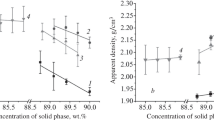Abstract
The dissolution of magnesium, aluminium, and silicon from S-glass rovings in water at 30, 40 and 50° C and from S-glass powders in water at 40° C has been studied. The concentrations of magnesium and silicon reached 2 mgl−1 or more depending upon the temperature and length of contact time, while the aluminium concentration reached no more than 0.2 mgl−1. The preferential leaching out of Mg (or MgO) by water from S-glass could be the initial step which causes and aggravates the degradation of S-glass filament reinforced composites. Weak ammonia solutions ranging from 0.04 to 0.00008 M enhanced the dissolution of aluminium and magnesium, especially that of the former. In the experiments with S-glass rovings in boiling water in Pyrex glass flasks, complications arose as a result of the interactions between the alkaline ingredients of the Pyrex wares and the ingredients of S-glass. Rate relations are proposed and discussed for the dissolution process.
Similar content being viewed by others
Abbreviations
- C g :
-
concentration of Mg in bulk glass (g cm−3)
- C gs :
-
concentration of Mg at the glass surface (g cm−3)
- C l :
-
concentration of Mg in liquid film immediate to glass surface (g cm−3)
- C b :
-
concentration of Mg in bulk liquid (g cm−3)
- D g :
-
diffusivity of Mg in solid phase (cm2sec−1)
- D l :
-
diffusivity of Mg in liquid phase (cm2sec−1)
- E a :
-
dissolution activation energy of Mg for S-glass-water system (cal g.mol−1)
- k d :
-
detachment rate coefficient of Mg from S-glass to water (cm sec−1)
- m :
-
reaction order for surface area
- n :
-
reaction order for concentration driving force
- R :
-
universal constant (cal g.mol−1 K−1)
- S :
-
surface area (cm2)
- T :
-
temperature (° K)
- V :
-
liquid volume (cm3)
- W :
-
mass of Mg in S-glass rovings used (g)
- α :
-
overall mass transfer coefficient, g Mg transferred per (sec) (cm2) (g Mg cm−3), or cm sec−1
- α′ :
-
proportionality coefficient in Equation 1
- β :
-
dimension correction factor betweenk d andk l, dimensionless
- δ :
-
solid phase diffusion path length (cm)
- ge :
-
equilibirum coefficient between Mg in the liquid phase and in the solid phase, dimensionless.ε=C l/C gs
- θ :
-
time (sec)
References
F. J. Mcgarry andM. Fujiwara, 23rd Annual Technical Conference, Reinforced Plastics/Composite Division, The Soc. of Plastics Industry, Sec. 9-B (1968).
J. L. Parham, Report No. RS-TR-70-8, US Army Missile Command, Redstone Arsenal, October 1970.
W. A. Jemian andR. C. Wilcox, Stability of Glass-Fiber Plastics Composites, Final Report, Contract DAAHO1-72-C-0294, School of Engineering, Department of Mechanical Engineering, Auburn University, Auburn, Alabama, October 1973.
G. E. Vogel, O. K. Johannson, F. O. Stark, andR. M. Fleischmann, Preprint 22nd Annual Meeting, Reinforced Plastics Div., Soc. of the Plastics Industry, Washington D. C. (1967).
W. J. Eakins,Soc. Plastics Eng. Trans. 1 (1961) 234.
W. D. Bascom,J. Adhesion 2 (1970) 161.
T. T. Chiao andR. L. Moore,J. Composite Mater. 6 (1972) 156.
R. E. Lowrie, in “Modern Composite Materials”, edited by L. J. Broutman and R. H. Krock (Addison-Wesley, Reading, Mass., 1967) p. 307.
L. A. R. Waring, in “Glass Reinforced Plastics”, edited by Brian Parkyn, (CRC Press, Cleveland, Ohio, 1970) p. 122.
W. D. Bascom andJ. B. Romans,I&EC Product Research and Development 7 (1968) 172.
F. J. Mcgarry, in “Fundamental Aspects of Fiber Reinforced Plastic Composites”, edited by R. T. Schwartz and H. S. Schwartz (Interscience, New York, 1968) p. 63.
“International Critical Tables”, Vol. 4 (McGraw-Hill, New York, 1928) p. 92.
F. D. Snell andC. A. Snell, “Colorimetric Methods of Analysis” (Robert E. Krieger, Huntington, N.Y. 1972) p. 175.
American Public Health Association, “Standard Methods for the Examination of Water and Waste-water”, 13th Edn., Washington, D. C. (1971) p. 308.
“Ländolt-Bornstein Physikalisch-Chemische Tabellen”, 2nd. supplement, (Springer, Berlin, 1931) p. 343.
“Properties of Glasses and Glass-Ceramics”, Corning Glass Works, October 1972, p. 5.
F. H. Garner andR. D. Suckling,AIChE J. 4 (1958) 114.
C. O. Bennett andJ. E. Myers, “Momentum, Heat and Mass Transfer”, 2nd Edn. (McGraw-Hill, New York, 1974) P. 574.
David O. Cooney,AIChE J. 18 (1972) 446.
Author information
Authors and Affiliations
Additional information
Paper presented at the American Institute of Chemical Engineers meeting, Atlantic City, New Jersey, 29 August–1 September 1976.



